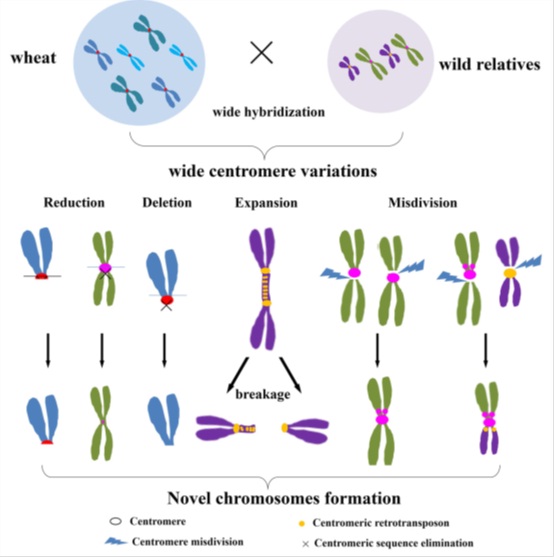PLOS Genetics:中科院遗传所韩方普研究组发表小麦远缘杂交及染色
2016年4月25日,国际知名学术期刊《PLOS genetics》发表了中国科学院遗传与发育生物学研究所韩方普研究组关于小麦远缘杂交及染色体工程研究进展文章,韩方普研究组的郭翔、苏汉东和石庆华为共同第一作者,韩方普为通讯作者。
早在上个世纪80年代,两位著名的小麦遗传学家Moshe Feldman和Ernest R. Sears曾提出“未来的谷物改良寄希望于野生基因资源的利用”。小麦育种的最大瓶颈是缺乏新的、可用的遗传资源。为了拓宽与改良小麦遗传资源,韩方普研究组一直致力于小麦与野生近缘种的杂交工作,利用长穗偃麦草和中间偃麦草育成高抗赤霉病、白粉病和锈病的六倍体小偃麦(Guo et al. 2015.JGG)。为了解决小麦生产的赤霉病问题,该研究组一直进行小麦-偃麦草易位系的研究工作。根据易位系染色体的着丝粒结构研究结果,也试图回答重复序列是否可以用于小麦育种工作。在完成上述目标的同时,该研究组对小麦及远缘杂交后代的染色体变异机制、易位系形成机制进行了系统研究。初步研究结果表明:植物着丝粒的错分裂可以形成新的易位系,全世界广泛应用的1B/1R易位系(70%左右的小麦品种含有这条易位染色体)是融合着丝粒,一半来自黑麦着丝粒,一半来自小麦着丝粒,黑麦着丝粒的特异反转座子是高效表达的。
最近,韩方普研究组利用小麦双端体系统研究着丝粒变异情况,发现4DS的着丝粒完全丢失CRW信号。以CENH3抗体的chip-seq分析并结合斑点杂交验证与分析新的基因组序列是否参与新着丝粒的形成,CENH3核小体在大约994kb的基因组序列上重新形成新的功能着丝粒。在其它双端体材料出现不同程度的着丝粒反转座子信号减弱的现象。对条锈病免疫的小麦-中间偃麦草附加系TAI-14及硬粒小麦-长穗草附加系均发现新着丝粒形成,着丝粒错分裂导致原来着丝粒丢失而在染色体臂上的某些部位形成新的着丝粒。外源染色体在小麦背景下可以发生着丝粒扩增及不对称重组而产生稳定遗传的双着丝粒区和三着丝粒区。黑麦的反转座子在小麦背景下发生新的变异,着丝粒特异反转座子激活转移到染色体臂但没有形成新的着丝粒。初步结果见图1。

图示:小麦及其远缘杂交过程着丝粒变异导致新的稳定染色体产生 。
原文链接:
De Novo Centromere Formation and Centromeric Sequence Expansion in Wheat and its Wide Hybrids
原文摘要:
Centromeres typically contain tandem repeat sequences, but centromere function does not necessarily depend on these sequences. We identified functional centromeres with significant quantitative changes in the centromeric retrotransposons of wheat (CRW) contents in wheat aneuploids (Triticum aestivum) and the offspring of wheat wide hybrids. The CRW signals were strongly reduced or essentially lost in some wheat ditelosomic lines and in the addition lines from the wide hybrids. The total loss of the CRW sequences but the presence of CENH3 in these lines suggests that the centromeres were formed de novo. In wheat and its wide hybrids, which carry large complex genomes or no sequenced genome, we performed CENH3-ChIP-dot-blot methods alone or in combination with CENH3-ChIP-seq and identified the ectopic genomic sequences present at the new centromeres. In adcdition, the transcription of the identified DNA sequences was remarkably increased at the new centromere, suggesting that the transcription of the corresponding sequences may be associated with de novo centromere formation. Stable alien chromosomes with two and three regions containing CRW sequences induced by centromere breakage were observed in the wheat-Th. elongatum hybrid derivatives, but only one was a functional centromere. In wheat-rye (Secale cereale) hybrids, the rye centromere-specific sequences spread along the chromosome arms and may have caused centromere expansion. Frequent and significant quantitative alterations in the centromere sequence via chromosomal rearrangement have been systematically described in wheat wide hybridizations, which may affect the retention or loss of the alien chromosomes in the hybrids. Thus, the centromere behavior in wide crosses likely has an important impact on the generation of biodiversity, which ultimately has implications for speciation.
doi:10.1371/journal.pgen.1005997
作者:韩方普

